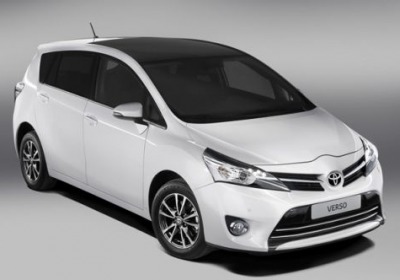Toyota launches BMW-powered Verso in Europe
Tue, 03 Dec 2013BMW makes some sweet-revving engines, but its own vehicles aren't the only ones running BMW engines. So do the latest from Rolls-Royce and Mini, of course, as well as a handful of Peugeots and Citroëns thanks to its joint engine program with PSA. Wiesmann uses BMW engines, as did the famous McLaren F1. And now we can add one more to the list.
That would be the Toyota Verso, a Corolla-based minivan which Toyota builds in Turkey and sells in Europe and a few other markets overseas. The Verso is also now officially the first beneficiary of the partnership between Toyota and BMW as the Japanese automaker has released the MPV with BMW's 1.6-liter turbodiesel four.
The 111-horsepower engine is coupled to a Toyota transmission and joins the Verso range as the fourth (and least powerful) engine in the lineup, alongside the 122hp 2.0 diesel and the gasoline options with 1.6 liters and 160 hp and 1.8 for 180. Future collaborations between the two automakers will include fuel-cell development, a new joint sportscar platform, lightweight bodywork research and a new generation of lithium-air batteries. See the press release below for further details.
VERSO FIRST TOYOTA TO USE NEW BMW-SUPPLIED 1.6-LITRE DIESEL ENGINE
KEY POINTS
- New Verso 1.6 D-4D to be launched early in 2014, the first Toyota to be equipped with a BMW-sourced engine
- Toyota Motor Europe engineers ensured seamless integration of new engine and vehicle
- Agreement to supply diesel engine is first step in a mid-to-long-term collaboration between Toyota and the BMW Group on next-generation environmentally efficient technologies
- The Verso 1.6 D-4D compact MPV will be the first Toyota be equipped with an engine supplied by the BMW Group under a contract agreed by the manufacturers two years ago.
The addition of the 111bhp/83kW engine to the range early in 2014 will increase the number of powertrains available to Verso customers in the UK to four, as detailed in the table below.
| DIESEL | PETROL | |||
| Engine | New 1.6 D-4D | 2.0 D-4D | 1.6 Valvematic | 1.8 Valvematic |
| Power (bhp/kW @ rpm) | 111/83 @ 4,000 | 122/91 @ 3,600 |
130/97 @ 6,400 |
145/108 @ 6,400 |
| Torque (Nm @ rpm) | 270 @ 1,750 – 2,250 |
310 @ 1,600 – 2,400 |
160 @ 4,400 | 180 @ 4,000 |
| CO2 (g/km) | 119 | 129 | 154 | 159 |
"Working together with an industry leader like the BMW Group allows us to benefit from economies of scale to reduce development costs as well as improve our time-to-market."
The R&D team at Toyota's European technical centre in Belgium led the development of the Verso 1.6 D-4D, ensuring a seamless match between the engine and the Toyota transmission and electronics. At the same time they safeguarded the car's established ride comfort and dynamic performance. This involved the development of a number of new components, including engine mounts, a dual-mass flywheel, a newgearbox housing and gearing and a stop/start system to further improve efficiency and reduce emissions.
Production of the Verso 1.6 D-4D will begin in January 2014 at Toyota Motor Manufacturing Turkey's Adapazari plant, the centre for all Verso manufacturing.
Sourcing diesel engines is one aspect of a wider collaboration between Toyota and the BMW Group, under which the companies have announced plans to:
- Co-develop a fuel cell system
- Conduct a feasibility study for the joint development of a sports car platform
- Work together on creating lightweight vehicle body technologies
- Undertake joint research into lithium-air batteries
By Noah Joseph
See also: BMW 2 Series, X5 get their M Performance parts on, Is the BMW i8 actually already sold out?, Ford Fusion production scaled back just 3 months after it was accelerated.

